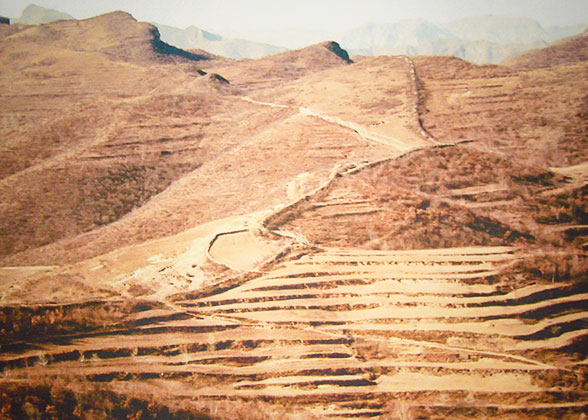Great Wall in Tang Dynasty
The China Great Wall of the Tang Dynasty (618-907) only has a few sections left, for Tang was the only unified Han regime of Imperial China not to build the Great Wall on a large scale. Some passes and walls were built in its early years to protect the newly-founded dynasty from hostile nomads from the north. During its long reign of nearly 300 years, the Tang Empire became more and more powerful and prosperous, reaching the pinnacle of ancient Chinese civilization and becoming the center of East Asian world at that time. However, there was no more construction of the Great Wall. Was it due to a lack of money or manpower? Definitely not!
Why Didn't Tang Dynasty Build the Great Wall Extensively?
 |
| Tang Dynasty Great Wall in Chicheng County of Hebei Province |
1. Confidence in Military Strength
The Tang Dynasty was proud of its strong national power and military force which ensured that it always had an edge over northern nomads on the battlefield. The Tang Dynasty defeated the nomadic Turks and Uighurs in the north, who had posed a threat to the central plain. Thus, Tang was powerful enough to protect its frontier and there was no need to build a wall to block the nomads.![]() See Military Power of Tang Dynasty
See Military Power of Tang Dynasty
2. Aggressive and Expansionist Foreign Policy
Among all the regimes ruled by the Han People in Chinese history, the Tang Dynasty was the only one to adopt an expansionist foreign policy. It preferred attacking to defending. Rather than build a wall to defend against enemies, Tang would actively fight back.![]() See Tang's Foreign Policies and Relations
See Tang's Foreign Policies and Relations
3. Territory Reaching Far North of Great Wall
After defeating the Eastern Turks in 630, the Tang Dynasty absorbed the Mongolian Plateau, and expanded its territory to the north of Lake Baikal. Its empire extended far beyond the Great Wall, so there was no need to extend the walls.
4. Major Threats from the South
In contrast to previous dynasties, the most dangerous threat to the Tang Dynasty was not from the north, but from the southwestern Tibetan Empire and southern Nanzhao Kingdom. The major target of national defense was the southwestern and southern borders, so the central government did not divert its attention from border defense to the construction of walls in the north.
5. Lesson from the Previous Sui Dynasty
The Great Wall construction by Emperor Yang of the Sui exhausted the whole nation, and sped up the demise of the Sui Dynasty. The Emperor of Tang drew a lesson from this. In his opinion, the construction of the Great Wall would cost too much, burdening the whole country. Winning hearts and minds was much more important to him. Thus, he disapproved of building the wall, and preferred appointing talented generals to protect the frontier.
Dispute over Possible Relics of the Great Wall of the Tang Dynasty
Historical records and field investigations show that the Great Wall relics in Yushe County of Shanxi Province are probably Tang Dynasty Great Wall.
When Emperor Gaozu, the first emperor of the Tang Dynasty, ascended the throne, fourteen regimes existed. The regime led by Liu Wuzhou was the biggest threat. In 619, Liu’s troops occupied Taiyuan of Shanxi Province, about 385 miles (620 kilometers) west of the capital city Chang’an, today’s Xi'an. In this critical circumstance, Emperor Gaozu sent his son, Li Shimin, to fight back, and ordered the Great Wall be built in Shanxi. Originally, the wall was 93 miles (150 kilometers) long, with fortresses and beacon towers, stretching along the mountain ridges from Pingcheng in today’s Heshun County to Lukou in today’s Qixian County.
Nowadays, the relics run from Malingguan Pass, via Shecheng Town of Yushe County, and reach Hengling Town of Heshun County. Ruins can be easily recognized at Malingguan Pass, Heiya Mountain, and Dahuo. At Malingguan Pass of Taigu County, the remnant wall is about 0.6 mile (1 kilometer) long, and relics of city gates are also found. The relics at Heiya Mountain are about 109 yards (100 meters) long, 1 yard (1 meter) wide, and 6.6 feet (2 meters) high. The ruins at Dahuo are about 219 yards (200 meters) long, 1 yard (1 meter) wide, and 3 feet (1 meter) high.
Some scholars believe that the relics are from the Tang Dynasty, while others contend that they are from the Northern Qi Dynasty (550-577). To date, there is still no final conclusion.